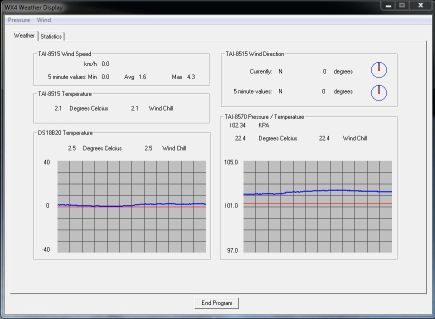VE3LNY's
Weather Station

Well not really...
VE3LNY's
Weather Station

Well not really...
 At
the right is a photo of the AAG Electronica 1-Wire Wind Instrument
(courtesy of
AAG Electronica). The basic
instrument contains a temperature sensor, a wind speed sensor, and a
wind direction sensor. Additional sensors are available for pressure,
humidity, etc. The basic unit is really inexpensive, since it uses your
computer as the display unit.
At
the right is a photo of the AAG Electronica 1-Wire Wind Instrument
(courtesy of
AAG Electronica). The basic
instrument contains a temperature sensor, a wind speed sensor, and a
wind direction sensor. Additional sensors are available for pressure,
humidity, etc. The basic unit is really inexpensive, since it uses your
computer as the display unit.
The idea of the one-wire system is to use a single wire for both power and data. (You also need a ground return, of course, which means two wires, and in many installations where long runs are used, shielded twisted pair gives the best results.) The kit includes a DS9097U serial interface or, for a small additional cost, you can get the DS9490R USB interface, or a LINK interface.
The one-wire network is based on a series of ICs developed by Dallas Semiconductor, now part of Maxim Integrated Products, Inc. Software and developer's kits for one-wire devices may be found at the iButton web site. AAG's application programs are available along with the weather station kits. Sourceforge's Weather Station Hardware contains a really good overview of the various one-wire hardware.
What appeals to me about the AAG one-wire system (aside from the low cost) is that programmers can develop their own applications for these instruments. The iButton site contains source code for a low-level support package called OWPD (one wire public domain) which relieves you of the low-level interface to the devices, and lets you concentrate on the user interface. Alternatively, there is an interface available called TMEX for Windows programmers. In addition, a search of the links reveals numerous software implementations, some free and some with cost. There is Java code available and implementations that update a WEB server so others can access your weather in real time.
Currently I am operating the basic weather station for wind speed and direction. The temperature sensor is only partly useful; since the instrument is not shielded from the sun, it is only accurate at night and on cloudy days. I recently added a TAI8570 1-Wire Pressure Sensor and a DS18B20 Temperature Sensor. The pressure sensor also includes a thermometer. These sensors must be installed in a protected enclosure, so the temperature sensor should be accurate all the time. In my case the pressure sensor is installed indoors, since the pressure is usually the same inside or out, and the DS18B20 is installed outdoors under the eves on the north side of my house.

My application program (uses TMEX):

